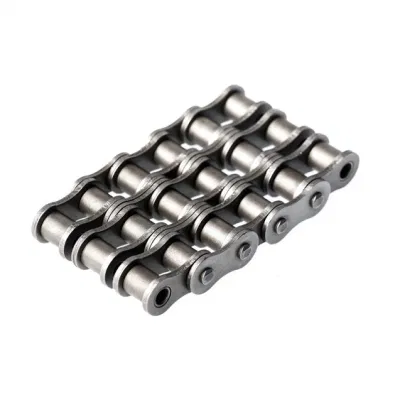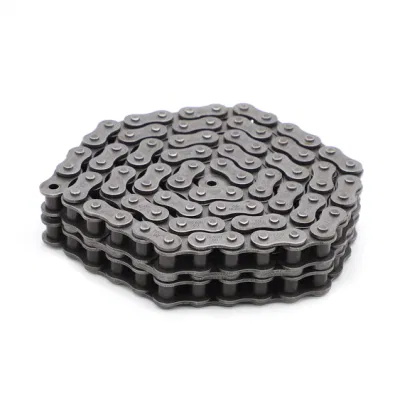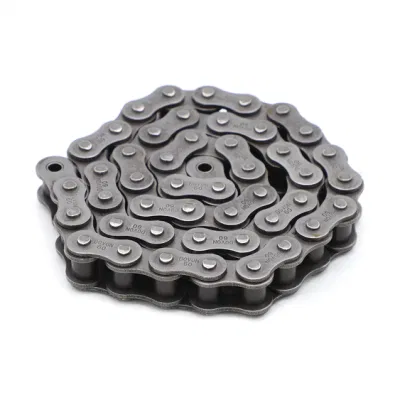Product Description
A Series Short Pitch Precision Multiple Strand Roller Chains & Bush Chains
|
ANSI |
Chain No. |
Pitch
P |
Roller diameter
d1max |
Width between inner plates b1min mm |
Pin diameter
d2max |
Pin length | Inner plate depth h2max mm |
Plate thickness
Tmax |
Transverse pitch Pt mm |
Tensile strength
Qmin |
Average tensile strength
Q0 |
Weight per meter q kg/m |
|
| Lmax mm |
Lcmax mm |
||||||||||||
| 60-6 | 12A-6 | 19.050 | 11.91 | 12.57 | 5.94 | 139.8 | 141.8 | 18.00 | 2.42 | 22.78 | 190.8/42921 | 209.80 | 9.31 |
ROLLER CHAIN
Roller chain or bush roller chain is the type of chain drive most commonly used for transmission of mechanical power on many kinds of domestic, industrial and agricultural machinery, including conveyors, wire- and tube-drawing machines, printing presses, cars, motorcycles, and bicycles. It consists of a series of short cylindrical rollers held together by side links. It is driven by a toothed wheel called a sprocket. It is a simple, reliable, and efficient means of power transmission.
CONSTRUCTION OF THE CHAIN
Two different sizes of roller chain, showing construction.
There are 2 types of links alternating in the bush roller chain. The first type is inner links, having 2 inner plates held together by 2 sleeves or bushings CHINAMFG which rotate 2 rollers. Inner links alternate with the second type, the outer links, consisting of 2 outer plates held together by pins passing through the bushings of the inner links. The “bushingless” roller chain is similar in operation though not in construction; instead of separate bushings or sleeves holding the inner plates together, the plate has a tube stamped into it protruding from the hole which serves the same purpose. This has the advantage of removing 1 step in assembly of the chain.
The roller chain design reduces friction compared to simpler designs, resulting in higher efficiency and less wear. The original power transmission chain varieties lacked rollers and bushings, with both the inner and outer plates held by pins which directly contacted the sprocket teeth; however this configuration exhibited extremely rapid wear of both the sprocket teeth, and the plates where they pivoted on the pins. This problem was partially solved by the development of bushed chains, with the pins holding the outer plates passing through bushings or sleeves connecting the inner plates. This distributed the wear over a greater area; however the teeth of the sprockets still wore more rapidly than is desirable, from the sliding friction against the bushings. The addition of rollers surrounding the bushing sleeves of the chain and provided rolling contact with the teeth of the sprockets resulting in excellent resistance to wear of both sprockets and chain as well. There is even very low friction, as long as the chain is sufficiently lubricated. Continuous, clean, lubrication of roller chains is of primary importance for efficient operation as well as correct tensioning.
CHAIN STRENGTH
The most common measure of roller chain’s strength is tensile strength. Tensile strength represents how much load a chain can withstand under a one-time load before breaking. Just as important as tensile strength is a chain’s fatigue strength. The critical factors in a chain’s fatigue strength is the quality of steel used to manufacture the chain, the heat treatment of the chain components, the quality of the pitch hole fabrication of the linkplates, and the type of shot plus the intensity of shot peen coverage on the linkplates. Other factors can include the thickness of the linkplates and the design (contour) of the linkplates. The rule of thumb for roller chain operating on a continuous drive is for the chain load to not exceed a mere 1/6 or 1/9 of the chain’s tensile strength, depending on the type of master links used (press-fit vs. slip-fit)[citation needed]. Roller chains operating on a continuous drive beyond these thresholds can and typically do fail prematurely via linkplate fatigue failure.
The standard minimum ultimate strength of the ANSI 29.1 steel chain is 12,500 x (pitch, in inches)2. X-ring and O-Ring chains greatly decrease wear by means of internal lubricants, increasing chain life. The internal lubrication is inserted by means of a vacuum when riveting the chain together.
CHAIN STHangZhouRDS
Standards organizations (such as ANSI and ISO) maintain standards for design, dimensions, and interchangeability of transmission chains. For example, the following Table shows data from ANSI standard B29.1-2011 (Precision Power Transmission Roller Chains, Attachments, and Sprockets) developed by the American Society of Mechanical Engineers (ASME). See the references[8][9][10] for additional information.
ASME/ANSI B29.1-2011 Roller Chain Standard SizesSizePitchMaximum Roller DiameterMinimum Ultimate Tensile StrengthMeasuring Load25
| ASME/ANSI B29.1-2011 Roller Chain Standard Sizes | ||||
| Size | Pitch | Maximum Roller Diameter | Minimum Ultimate Tensile Strength | Measuring Load |
|---|---|---|---|---|
| 25 | 0.250 in (6.35 mm) | 0.130 in (3.30 mm) | 780 lb (350 kg) | 18 lb (8.2 kg) |
| 35 | 0.375 in (9.53 mm) | 0.200 in (5.08 mm) | 1,760 lb (800 kg) | 18 lb (8.2 kg) |
| 41 | 0.500 in (12.70 mm) | 0.306 in (7.77 mm) | 1,500 lb (680 kg) | 18 lb (8.2 kg) |
| 40 | 0.500 in (12.70 mm) | 0.312 in (7.92 mm) | 3,125 lb (1,417 kg) | 31 lb (14 kg) |
| 50 | 0.625 in (15.88 mm) | 0.400 in (10.16 mm) | 4,880 lb (2,210 kg) | 49 lb (22 kg) |
| 60 | 0.750 in (19.05 mm) | 0.469 in (11.91 mm) | 7,030 lb (3,190 kg) | 70 lb (32 kg) |
| 80 | 1.000 in (25.40 mm) | 0.625 in (15.88 mm) | 12,500 lb (5,700 kg) | 125 lb (57 kg) |
| 100 | 1.250 in (31.75 mm) | 0.750 in (19.05 mm) | 19,531 lb (8,859 kg) | 195 lb (88 kg) |
| 120 | 1.500 in (38.10 mm) | 0.875 in (22.23 mm) | 28,125 lb (12,757 kg) | 281 lb (127 kg) |
| 140 | 1.750 in (44.45 mm) | 1.000 in (25.40 mm) | 38,280 lb (17,360 kg) | 383 lb (174 kg) |
| 160 | 2.000 in (50.80 mm) | 1.125 in (28.58 mm) | 50,000 lb (23,000 kg) | 500 lb (230 kg) |
| 180 | 2.250 in (57.15 mm) | 1.460 in (37.08 mm) | 63,280 lb (28,700 kg) | 633 lb (287 kg) |
| 200 | 2.500 in (63.50 mm) | 1.562 in (39.67 mm) | 78,175 lb (35,460 kg) | 781 lb (354 kg) |
| 240 | 3.000 in (76.20 mm) | 1.875 in (47.63 mm) | 112,500 lb (51,000 kg) | 1,000 lb (450 kg |
For mnemonic purposes, below is another presentation of key dimensions from the same standard, expressed in fractions of an inch (which was part of the thinking behind the choice of preferred numbers in the ANSI standard):
| Pitch (inches) | Pitch expressed in eighths |
ANSI standard chain number |
Width (inches) |
|---|---|---|---|
| 1⁄4 | 2⁄8 | 25 | 1⁄8 |
| 3⁄8 | 3⁄8 | 35 | 3⁄16 |
| 1⁄2 | 4⁄8 | 41 | 1⁄4 |
| 1⁄2 | 4⁄8 | 40 | 5⁄16 |
| 5⁄8 | 5⁄8 | 50 | 3⁄8 |
| 3⁄4 | 6⁄8 | 60 | 1⁄2 |
| 1 | 8⁄8 | 80 | 5⁄8 |
Notes:
1. The pitch is the distance between roller centers. The width is the distance between the link plates (i.e. slightly more than the roller width to allow for clearance).
2. The right-hand digit of the standard denotes 0 = normal chain, 1 = lightweight chain, 5 = rollerless bushing chain.
3. The left-hand digit denotes the number of eighths of an inch that make up the pitch.
4. An “H” following the standard number denotes heavyweight chain. A hyphenated number following the standard number denotes double-strand (2), triple-strand (3), and so on. Thus 60H-3 denotes number 60 heavyweight triple-strand chain.
A typical bicycle chain (for derailleur gears) uses narrow 1⁄2-inch-pitch chain. The width of the chain is variable, and does not affect the load capacity. The more sprockets at the rear wheel (historically 3-6, nowadays 7-12 sprockets), the narrower the chain. Chains are sold according to the number of speeds they are designed to work with, for example, “10 speed chain”. Hub gear or single speed bicycles use 1/2″ x 1/8″ chains, where 1/8″ refers to the maximum thickness of a sprocket that can be used with the chain.
Typically chains with parallel shaped links have an even number of links, with each narrow link followed by a broad one. Chains built up with a uniform type of link, narrow at 1 and broad at the other end, can be made with an odd number of links, which can be an advantage to adapt to a special chainwheel-distance; on the other side such a chain tends to be not so strong.
Roller chains made using ISO standard are sometimes called as isochains.
Company Profile
The 219 sets of advanced automatic production equipment provide guarantees for high product quality. The 167 engineers and technicians with senior professional titles can design and develop products to meet the exact demands of customers, and OEM customizations are also available with us. Our sound global service network can provide customers with timely after-sales technical services.
We are not just a manufacturer and supplier, but also an industry consultant. We work pro-actively with you to offer expert advice and product recommendations in order to end up with a most cost effective product available for your specific application. The clients we serve CHINAMFG range from end users to distributors and OEMs. Our OEM replacements can be substituted wherever necessary and suitable for both repair and new assemblies.
Our Certifications
Safe Package and Shipment
Q:Why choose us ?
A. we are a manufacturer, we have manufactured valve for over 20 years .
B. Reliable Quality Assurance System;
C. Cutting-Edge Computer-Controlled CNC Machines;
D. Bespoke Solutions from Highly Experienced Specialists;
E. Customization and OEM Available for Specific Application;
F. Extensive Inventory of Spare Parts and Accessories;
G. Well-Developed CHINAMFG Marketing Network;
H. Efficient After-Sale Service System
Q. what is your payment term?
A: 30% TT deposit, 70% balance T/T before shipping.
Q:Can we print our logo on your products?
A: yes, we offer OEM/ODM service, we support the customized logo, size, package,etc.
Q: Can you make chains according to my CAD drawings?
A: Yes. Besides the regular standard chains, we produce non-standard and custom-design products to meet the specific technical requirements. In reality, a sizable portion of our production capacity is assigned to make non-standard products.
Q: what is your main market?
A: North America, South America, Eastern Europe, Western Europe, Southeast Asia, Africa, Oceania, Mid East, Eastern Asia,
Q: Can I get samples from your factory?
A: Yes, Samples can be provided.
Q: If products have some quality problem, how would you deal with?
A: We will responsible for all the quality problems.
| Standard or Nonstandard: | Standard |
|---|---|
| Application: | Textile Machinery, Garment Machinery, Conveyer Equipment, Packaging Machinery, Electric Cars, Motorcycle, Food Machinery, Mining Equipment, Agricultural Machinery, Car, Textile Machinery, Garment Machinery |
| Surface Treatment: | Polishing |
| Structure: | Roller Chain |
| Material: | Alloy |
| Type: | Derrlck, Bush Chain |
| Samples: |
US$ 0/Meter
1 Meter(Min.Order) | |
|---|
| Customization: |
Available
| Customized Request |
|---|

Can a bush chain be used in food processing industries?
Yes, bush chains can be used in food processing industries, provided that they meet certain criteria to ensure food safety and hygiene. When selecting a bush chain for food processing applications, several factors should be considered:
1. Material compatibility: The chain material should be food-grade and suitable for contact with food products. Stainless steel, particularly austenitic stainless steel grades like 304 and 316, is commonly used due to its corrosion resistance, durability, and ease of cleaning. These materials are non-toxic and do not contaminate the food.
2. Lubrication: In food processing applications, it is important to consider the lubrication requirements. Some bush chains are available with self-lubricating properties or require food-grade lubricants that are safe for incidental contact with food. This ensures that the lubrication used does not pose a risk of contamination.
3. Cleanability: The bush chain should be designed in a way that allows for easy cleaning and maintenance. Smooth surfaces, without crevices or hard-to-reach areas, are preferred to prevent the accumulation of food particles, bacteria, or other contaminants. The chain should also withstand frequent cleaning processes, including washdowns with cleaning solutions or high-pressure water.
4. FDA and regulatory compliance: It is important to ensure that the bush chain and associated components comply with relevant food safety regulations, such as those set by the FDA (Food and Drug Administration) in the United States or similar regulatory bodies in other countries. Compliance with these regulations helps to maintain food safety standards.
5. Sanitary design: The bush chain should adhere to sanitary design principles, which include features such as smooth surfaces, no exposed threads, and easy disassembly for cleaning. This helps prevent the growth of bacteria and ensures the chain can be effectively sanitized.
By considering these factors and selecting a bush chain that meets the specific requirements of the food processing industry, it is possible to use bush chains safely and effectively in various applications, including conveying, sorting, packaging, and processing of food products.

Can a bush chain be used in corrosive or harsh environments?
Yes, a bush chain can be used in corrosive or harsh environments, but it requires careful selection and proper maintenance to ensure optimal performance and longevity. Here are some considerations:
1. Material Selection: When operating in corrosive environments, it is crucial to select a bush chain made from corrosion-resistant materials such as stainless steel or specialty alloys. These materials offer enhanced resistance to corrosion and chemical attack.
2. Coatings and Surface Treatments: Applying coatings or surface treatments to the bush chain can provide additional protection against corrosion. For example, coatings like zinc plating, nickel plating, or chemical treatments can help inhibit rust and corrosion.
3. Sealing and Protection: In harsh environments, it is essential to protect the bush chain from contaminants and corrosive substances. Enclosing the chain in a protective housing or using seals, covers, or boots can help prevent the entry of corrosive agents and debris.
4. Proper Lubrication: Adequate lubrication is crucial for reducing friction and preventing corrosion. Choose lubricants specifically designed for use in corrosive environments, such as those with anti-corrosion additives. Regular lubrication maintenance is necessary to ensure the chain remains well-lubricated and protected.
5. Cleaning and Maintenance: Regular cleaning and maintenance are vital to remove any corrosive substances or contaminants that may have accumulated on the chain. This includes thorough cleaning, inspection, and re-lubrication as necessary.
It is important to consult with chain manufacturers or industry experts to determine the most suitable bush chain and maintenance practices for the specific corrosive or harsh environment. By implementing these measures, a bush chain can effectively operate and withstand the challenges posed by corrosive or harsh conditions.

What are the main components of a bush chain?
A bush chain consists of several key components that work together to enable efficient power transmission. The main components of a bush chain include:
1. Bushings: Bushings are cylindrical components with a hollow bore that fit into the chain links. They provide a low-friction interface between the chain pins and the link plates, allowing smooth rotation and reducing wear.
2. Pins: Pins are cylindrical metal rods that connect the inner plates and outer plates of the chain links. They pass through the bushings and provide the rotational movement of the chain. The pins are hardened and precisely machined to withstand the loads and provide durability.
3. Link Plates: Link plates are flat metal plates that are connected by the pins. They form the main structure of the chain and transmit the tensile forces. The link plates are typically made of high-strength steel and are designed to withstand the applied loads.
4. Rollers: Some bush chains feature rollers that are located between the link plates and the bushings. These rollers allow smoother engagement with sprockets or other mating components, reducing friction and enhancing the chain’s performance. Rollers also help to maintain proper chain tension.
5. Retaining Clips or Rivets: Retaining clips or rivets are used to secure the pins in place and prevent them from rotating within the link plates. They ensure the integrity of the chain assembly and maintain the proper alignment of the components.
6. Lubrication: Lubrication is crucial for the proper functioning and longevity of a bush chain. It helps to reduce friction, minimize wear, and prevent corrosion. Lubrication can be applied through various methods, such as oil bath, oil drip, or periodic lubrication.
These components work together to provide reliable power transmission in bush chain systems. The precise design and construction of each component contribute to the overall strength, durability, and efficiency of the chain.


editor by CX 2023-09-25
